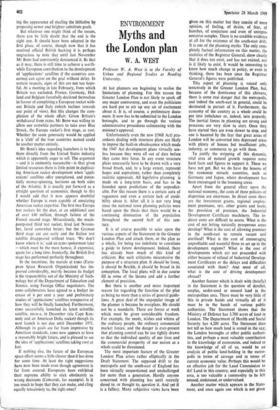Myths and the London plan
ENVIRONMENT W. A. WEST
Professor W. A. West is at the Faculty of Urban and Regional Studies at Reading University.
At last planners are beginning to realise the limitations of planning. For this reason the Greater London Plan is not likely to spark off any major controversy, and even the politicians are hard put to stir up any air of excitement about it. It is, of course, a preliminary docu- ment. It now has to be submitted to the London boroughs, and to go through the various administrative procedures culminating with the minister's approval.
Unfortunately even the new (1968 Act) pro- cedures dealing with structure plans are likely to impose the built-in obsolescence which made the 1947 Act development plans virtually use- less because they were all out of date before they came into force. In any event structure plans necessarily have to be drawn with a very broad brush, and, to a large extent, represent hopes and aspirations, rather than completely realistic appraisals. All legislative planning is made on a long-term basis, and has to be founded upon predictions of the unpredict- able. For this reason there is a certain aura of vagueness and even a certain lack of credi- bility about it. After all it is not very long since the national town planning policies were based upon the thesis that there would be a continuing diminution of the population throughout the second half of this cen- tury.
It is of course possible to seize upon the various aspects of the Statement in the Greater London Plan and attack them, or the plan as a whole, for being too indefinite to constitute a guide to future development. Indeed, there has already been much of this kind of criticism. But such criticisms misconceive the purpose of a structure plan. It should be loose, it should be flexible, it should be broad in its conception. The local plans will in due course fill in some of the lacuna and add a further element of precision.
But there is another and more important reason for regarding the function of the plan as being no more than a series of general guide- lines. A great deal of the unpopular image of the planner is because he overplans. He should not be a mandarin. There are forces at work which must be given considerable freedom. For example, the needs, wishes and whims of the ordinary people, the ordinary commercial market forces; and the danger is ever-present that planning control can be too tightly drawn so that the individual quality of our lives and the commercial prosperity of our nation as a whole could be threatened.
The most important feature of the Greater London Plan arises rather elliptically in the Draft Statement. The supposed drift to the metropolis and the south-east of England has been virtually unquestioned and unchallenged for more than a generation. Hardly anyone concerned with planning has until recently dared to, or thought to, question it. And yet it is a fallacy. Many subjective views have been given on this matter but they consist of mere opinion, of feeling, of desire, of fear, of hunches, of conjecture and even of unrepre- sentative samples. There is no credible evidence at all for the existence of the south-east drift. It is one of the planning myths. The only com- pletely factual information on this matter, the statistics of the Registrar General, show clearly that it does not exist, and has not existed, nor is it likely to exist. It would be interesting to know how much change in policy, or even in thinking, there has been since the Registrar General's figures were published.
This aspect of planning is voiced only tentatively in the Greater London Plan, but, because of the dominance of this chimera, there is some real danger that the metropolis, and indeed the south-east in general, could be decimated in pursuit of it. Furthermore, the economy of the country as a whole could be put into imbalance or, indeed, into jeopardy. The inertial forces in planning are strong and processes are very slow to start. Once they have started they are even slower to stop, and one is haunted by the fear that great areas of London will be converted into depressed areas with plenty of houses but insufficient jobs, industry, or commerce to go with them.
To justify the stripping of this dynamic, vital area of natural growth requires some hard facts and figures to support it. These we have not got. But we do have the lessons of the economic miracle countries, such as Germany and Japan, where development has been encouraged in the booming areas.
Apart from the general effect upon the national economy, the costs of these policies of dispersion are enormous. In direct costs there are the investment grants, regional employ- ment premiums, SET, other grants and loans, the provision of premises, the Industrial Development Certificate machinery. The in- direct costs are difficult to assess. What is the cost of not letting naturally prosperous areas develop? What is the cost of allowing premises in the south-east to remain vacant and sterilised? What is the cost of encouraging unprofitable and wasteful firms to set up in the development regions? What is the cost of developments which are not proceeded with either because of refusal of Industrial Develop- ment Certificates or the delays and difficulties associated with them? And most of all, what is the cost of driving development abroad?
Another feature which is dealt with (briefly) in the Statement is the question of derelict, surplus, under-used or unused land in the metropolitan area. There must be very little of this in private hands and virtually all of it must be in the hands of various public authorities. The Statement shows that the Ministry of Defence has 3,700 acres of land in London. The Department of Health and Social Security has 4,200 acres. The Statement does not tell us how much land is vested in the GLc, the London boroughs or other public authori- ties, and perhaps a most valuable contribution to the knowledge of economists, and indeed to the knowledge of all of us, would be an analysis of public land-holding in the metro- polis in terms of acreage- and in terms of current economic value. Perhaps this would be an effective job for the Land Commission to do! Land in this country, and especially in this area, is too valuable a commodity to be left unused, underused, or undervalued.
Another matter which appears in the State- ment, and once again one which is not given
due importance, is the Green Belt. The noble concept of the Green Belt at its inception has, two generations later, shown very disappoint- ing results. It has driven up property values and given an entirely unearned increment to the lucky owners of developed property in the plushy residential areas. In effect, whilst it has done much to quantify the principle `to him that hath shall it be given,' it has left for the rest of us little more than a glimpse of green seen over private walls and hedges. The Green Belt today serves little purpose other than delineating the optimum metro- politan area. In political and emotional terms it appears to be inviolable but there seems to be no reason for not accepting the proposal tentatively hinted at in the Development Plan Statement that certain areas of the Greeen Belt should be dedicated to recreational purposes. Other areas should be allocated to carefully controlled residential development. This would do something to bring down the price of land. After all, in broad terms, there is no shortage of land; there is only a shortage of planning permissions and the major inflationary factor in building-land is the dearth of planning permissions—as the Land Commission has discovered at last. When something is done
about this, the price of land and the consequent price of houses will come down. Unless some- thing is done, the price will be driven up even further.
The controversial road plans when seen in the context of the general structure have to be regarded as acceptable, and indeed the only practical solution to this problem. Of course, social, legal and economic developments can bring much of this type of projection to naught. New inventions, industrial changes, new means of communication and many other factors can completely alter the picture of the future. Furthermore, changes in legislative policy, for example in the Rent Acts and Housing Acts, could vastly affect the shape of future plans. But even on existing data, one would have thought that the plan should have given a greater measure of attention to improvements in the public transport sys- tem.
Nevertheless the plan appears as a whole to deserve a merit mark as a good attempt. Its general aims seem to be in accordance with realism and common sense. Moreover it presents a new and praiseworthy element in planning practice—it implicitly recognises the limits of planning capability.



































 Previous page
Previous page